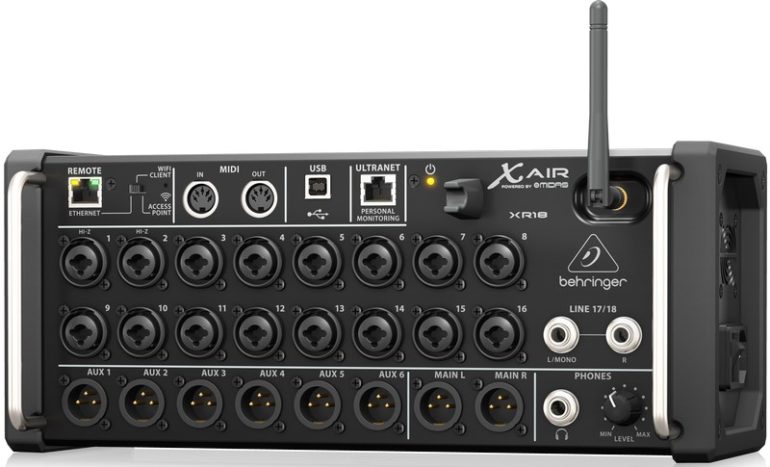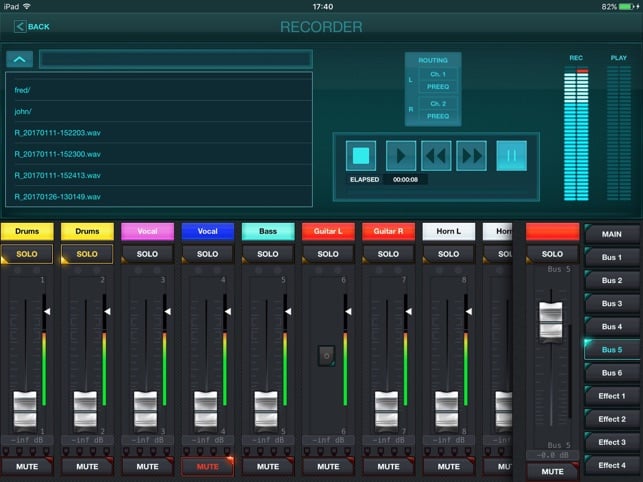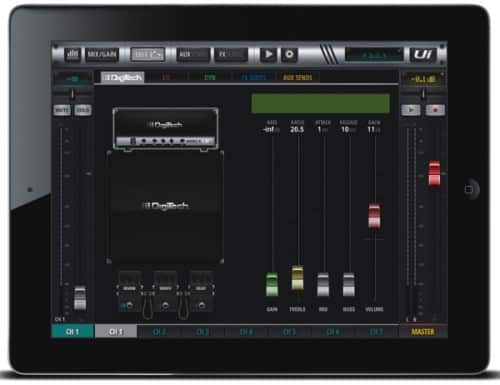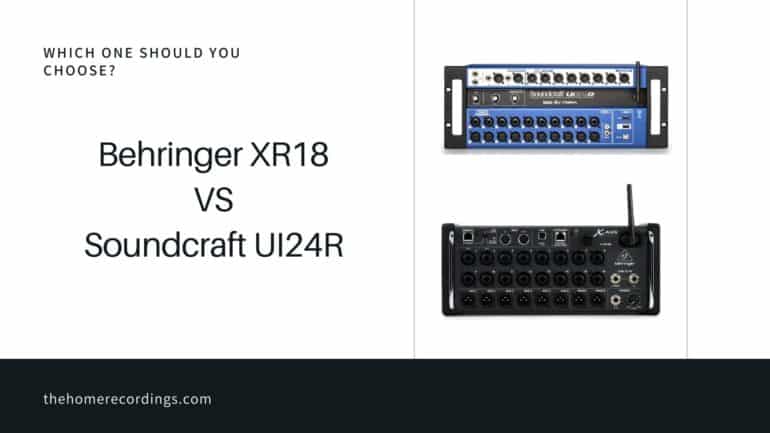Last updated on December 30th, 2023 at 02:52 pm
I recently wrote a post about the two other Behringer and Soundcraft mixers, which you should definitely check out…
Those mixers, however, lack one very important feature which is multi-track recording.
This is where the Behringer XR18 and the Soundcraft UI24R come in, since both of them can do everything those mixers can, while still being able to do multi-track recording.
Multitrack recording just means that every input gets recorded on-to its own track in the DAW, while with the more conventional mixers all the tracks get combined into one stereo file.
Note: Of course, having this added feature means that the mixer has a built-in Audio Interface, which increases its overall cost.
Let’s get started!
Behringer X Air XR18

The Behringer XR18 is a digital mixer which features a 18-in/18-out USB audio interface.
This basically means that every one of those 18 inputs can be recorded on-to its own track in the DAW.
Let’s take a quick look at the Behringer XR18’s inputs and outputs:
Inputs: 16 of the inputs are XLR/TRS combo Jacks which feature their famous MIDAS preamps, and an additional 2 x TRS line inputs, as well as MIDI I/O.
The quality of these preamps is actually pretty good, providing you with an excellent signal-to-noise ratio and good headroom.
Both of the first two inputs are also Hi-Z inputs, which allow you to connect an electric guitar without the need of using a D.I. box.
Outputs: As far as the outputs go, it comes with 2 x XLR Main outputs, the ultranet port, 6 XLR Aux bus outs, and ¼” TRS headphone output.
The 6 aux outputs can be used to create headphone mixes, or for live monitoring…
While the “Ultranet” port, which connects to the Behringer’s P16 monitor distribution system, allows every musician to create their own headphone mix or their own monitor mix on stage.
The Behringer X-Air XR18 can be controlled via Wi-Fi -with a built-in router- or ethernet, using an Andrioid or iOS device via the X-Air App, which gives you an overview of what’s going on in the mixer.
This app works almost like a DAW and comes included with loads of effects.
Here’s how the X-Air App looks;

It even has an Auto-Mix feature which can manage fully automated mixes with up to 16 live microphones…
This feature, however, is not really intended for mixing live music, but rather conferences.
When it comes to cost-efficiency, the Behringer XR18 is one of the best wireless multitrack mixers out there…
It super affordable for what you are getting.
Onboard Effects
As far as the effects go, it comes with four built-in true-stereo (8 mono) multi-effects processors, including delay, chorus, and dynamics, as well as a 31-band EQ.
You can also choose any combination of high-end simulations of classic studio reverbs such as the Lexicon 480L and PCM70, the EMT250 or Quantec QRS.
Sadly, there is no included feedback rejection/feedback fighting on these mixers, as well as no amp simulation, which do come included with the Soundcraft mixers.
Features
- 18-in/18-out USB interface which allows for multitrack recording
- Good onboard effects
- Midas preamps
- Durable and portable build
Specifications
| Model | Behringer XR18 |
| Channels | 18 |
| Inputs | 16 x XLR/TRS, 2 x ¼” line |
| Outputs | 2 x XLR main, ultranet port, 6 XLR AUX |
| MIDI I/O | Yes |
| Headphone Output | 1 x ¼” TRS |
| EQ | 100-band Real Time Analyzer (RTA) |
| Rackmountable | Yes |
| Multi-track Recording | Yes |
| USB Rec/Playback | No |
| App required | X-Air App |
| Feedback Control | No |
Find out more about the Behringer X Air XR18 here:
- Behringer X Air XR18: Amazon, Sweetwater.
Soundcraft UI24R

This wireless mixer features a 24-in/24-out audio interface, which means that every single track can be recorded separately on-to your DAW.
Let’s take a quick look at the inputs and outputs:
Inputs: It comes with 10 x XLR/1/4″ combo jacks, as well as 10 x XLR jacks all equipped with their Studer-designed preamps.
Not only that, but there’s an additional 1 x stereo RCA connection.
Outputs: It comes with 2 x XLR and 2 x 1/4″ main outputs, as well as 8 x XLR (aux outs), and lastly 2 x ¼” headphone outputs.
The first two inputs are also Hi-Z inputs which feature DigiTech’s amp modelling.
These inputs are designed to connect an electric guitar/bass directly to the mixer without the need of using a D.I. box.
This can definitely come in handy during live gigs where you don’t want to take guitar amps along, since these amp sims actually sound quite convincing.
The great thing about the Soundcraft wireless mixers is that you can connect to them through Wi-Fi and control their internal software via any HTML5-compatible browser…
And basically, every device out there can run such a browser (Chrome, FireFox, Safari, etc).
In this Image you can see how the software actually looks;

Note: It also has an Ethernet port, should you want to take wired control of this digital mixer via your computer or laptop.
Most wireless mixers require you to download an app, but with the Soundcraft mixers you just connect to the Wi-Fi they provide, and that’s it!
Not only that, but you can connect up to 10 different devices, which means that every band member can control their own effects, monitor mix, amp sim, etc.
There is even an HDMI output and an extra USB port, so that you can hook up a monitor and mouse, if you want to control it that way.
Moving on…
Onboard Effects
This mixer comes with the Lexicon effects, which include; reverbs, delay, and chorus.
Each channel also has Compression, de-essing, and noise-gating built in, plus a real time frequency analyzer.
Like I mentioned earlier, amp emulation for the first two inputs is also included, which provides a huge array of amps, cabinets, pedal effects, and more.
Feedback Fighting
The Soundcraft wireless mixers come with an advanced feedback suppression algorithm which listens to the incoming signal and can anticipate the problematic frequencies before the feedback begins.
This feedback suppression system won’t affect the sound of the performance one bit!
Recording capabilities
Not only can you record all of the tracks directly on-to your DAW, but you can also connect an external USB drive and playback music from it.
Features
- 22-simultaneous tracks can be recorded
- Can be controlled via any device that can open a browser
- Built-in effects and amp sims
- Integrated Wi-Fi connects up to 10 devices simultaneously
- 2-channel feedback suppressor
- Solid construction and design
Specifications
| Model | Soundcraft UI24R |
| Channels | 24 |
| Inputs | 10 x XLR, 10 x XLR/TRS Combo Jacks, 1 stereo RCA |
| Outputs | 2 x XLR and 2 x ¼” Main, 8 x XLR Aux Outs |
| MIDI I/O | No |
| Headphone Output | 2 x ¼” TRS |
| EQ | 4-band parametric EQ, 31-band graphic EQ |
| Rackmountable | Yes |
| Multi-track Recording | Yes |
| USB Rec/Playback | Yes |
| App required | No, Just browser |
| Feedback Control | Yes |
Find out more about the Soundcraft UI24R here:
- Soundcraft UI24R: Amazon, Sweetwater.
Differences
The Soundcraft UI24R features feedback suppression and amp simulations, as well as USB Rec/Playback capabilities, which the Behringer XR18 doesn’t.
However, the Behringer XR18 provides MIDI In/Out, which the Soundcraft doesn’t.
Which one to choose?
I Personally prefer the Soundcraft mixers a lot more simply because of all the added features like amp simulation and feedback suppression.
However, the Soundcraft UI24R mixer is way more expensive… almost twice as much.
And this isn’t something that you can ignore.
Sadly, Soundcraft doesn’t have any other wireless mixers capable of multitrack recording other than the UI24R.
This is why, unless you know that you’re going to use the 24 inputs, as well as the amps sims, etc., I’d recommend the Behringer XR18.
At half the price, I think that it’s just a much better choice overall.
Conclusion
No matter which mixer you go for, you’ll get an excellent product.
I wouldn’t really recommend them that much for a home studio though, since having to use a tablet or iPad to control it can be quite the hazzle.
If you want to find out more about good home studio mixers, then check this article I wrote.
I hope this information was useful!
Have an excellent day!

Hello, thanks for the great review! In our church, we are looking for a system that would solve the problem of the audibility of speakers who speak differently loudly or stand differently away from the microphone (Avtomatic Gain Control). We have quiet and loud individuals (speakers) in the church and it would be very good for everyone to be equally audible. I wonder if the UI24R or XR 18 has a feature to automatically gain the voice of an individual and tune to a preset level. Thank you in advance, Uroš
I have been offered the option to purchase either the Ui24R or XR18. Strangely, the Ui24R is being offered at a cheaper price. (Do not know the reason). Which one should I go for?
Thanks for the comparison, it’s very helpfull.
In a live situation, would the guitarist be able to dis/enable FX on his amp emulation channel? With a midi controller perhaps? Especially overdrive would be a big plus.
Like a real amp, it would be nice if the guitarist would be able to switch between the clean and the dirty (overdrive) channel.